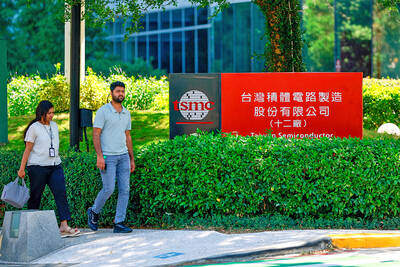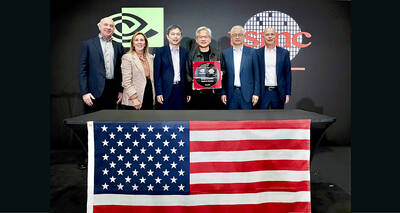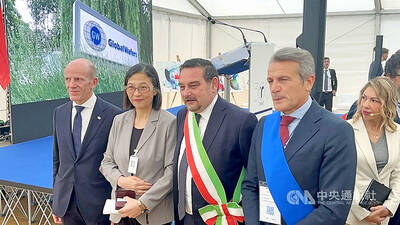Powerchip Semiconductor Corp (力晶半導體), the nation's biggest computer memory chipmaker, said yesterday that it did not plan to slow its capacity expansion, or reduce its exposure in the spot market despite the continual drop in memory chips prices amid a supply glut.
As of yesterday, the price of a Powerchip share has dropped nearly 30 percent this year to NT$15.2. The price of dynamic random access memory (DRAM) chips have plunged more than 77 percent to around US$1.36 per unit yesterday, market researcher DRAMeXchange Technology Inc (集邦科技) said.
That would put most memory chipmakers under heavy pressure to turn a profit.
Powerchip said in July that it was struggling to turn a profit after prices slid to below US$1.5 per unit.
Rivals Elpida Memories Inc of Japan and Hynix Semiconductor Inc of South Korea said last week that they planned to reduce, or even stop selling chips to the spot market in a bid to stem the price decline.
"Powerchip is the biggest memory chip supplier on the spot market. We will not change this business model. Our expansion plans are also on schedule," company spokesman Eric Tan (譚仲民) told the Taipei Times yesterday.
"We do not want to lose market share by reducing supply, or cutting capacity," Tan said. "And we believe that the DRAM price is hitting the bottom."
Powerchip planned to spend NT$71 billion (US$2.18 billion) on new facilities and equipment this year.
Powerchip said its production would grow around 75 percent annually this year, with half of the increase coming from Rexchip Electronics Corp (瑞晶電子), a 50-50 joint venture with Elpida.
Rexchip produces 30,000 12-inch wafers a month at its first plant in Taichung. It planned to more than double monthly production -- to as much as 70,000 wafers -- in the first half of next year as planned, Tan said.
Rexchip held an opening ceremony for its first 12-inch wafer plant yesterday, which was attended by its chairman Frank Huang (黃崇仁) and Elpida president and CEO Yukio Sakamoto.
Rexchip announced late last year that it planned to spend NT$450 billion to build four 12-inch plants in Taiwan over the next five years.
It is now building the second plant in Taichung, which could start to make chips by the end of next year at the earliest, Tan said.
As for Powerchip, its plan to build two new plants in Hsinchu was stalled this summer when it was unable to obtain land from the government, Tan said.
The two new plants would produce NAND flash memory chips, which are used to store data for consumer electronics such as music players and digital cameras, Tan said.
He refuted a report carried by Bloomberg yesterday that the company would begin construction of the two plants later this year and start making flash memory chips by the fourth quarter of next year.
"It was just media speculation," he said, citing the lack of land for new plants.
Separately, Goldman Sachs Group Inc lowered its earnings estimates on Japanese semiconductor-equipment manufacturers, such as Tokyo Electron Ltd for next fiscal year, citing possible reductions in investments by chipmakers amid declining prices.
"A majority of Japanese semiconductor production equipment manufacturers will likely record lower sales and profits in FY2008,'' Shin Horie, Toshiya Hari and Mari Murakami, Tokyo-based analysts at Goldman Sachs, wrote in a report released on Thursday.
Goldman Sachs said that it expected chip investment to drop by 10 percent next year because foundries will be more cautious about investment and Taiwanese DRAM manufacturers may postpone spending in response to declining prices.
Additional reporting by Bloomberg

RECYCLE: Taiwan would aid manufacturers in refining rare earths from discarded appliances, which would fit the nation’s circular economy goals, minister Kung said Taiwan would work with the US and Japan on a proposed cooperation initiative in response to Beijing’s newly announced rare earth export curbs, Minister of Economic Affairs Kung Ming-hsin (龔明鑫) said yesterday. China last week announced new restrictions requiring companies to obtain export licenses if their products contain more than 0.1 percent of Chinese-origin rare earths by value. US Secretary of the Treasury Scott Bessent on Wednesday responded by saying that Beijing was “unreliable” in its rare earths exports, adding that the US would “neither be commanded, nor controlled” by China, several media outlets reported. Japanese Minister of Finance Katsunobu Kato yesterday also

‘DRAMATIC AND POSITIVE’: AI growth would be better than it previously forecast and would stay robust even if the Chinese market became inaccessible for customers, it said Taiwan Semiconductor Manufacturing Co (TSMC, 台積電) yesterday raised its full-year revenue growth outlook after posting record profit for last quarter, despite growing market concern about an artificial intelligence (AI) bubble. The company said it expects revenue to expand about 35 percent year-on-year, driven mainly by faster-than-expected demand for leading-edge chips for AI applications. The world’s biggest contract chipmaker in July projected that revenue this year would expand about 30 percent in US dollar terms. The company also slightly hiked its capital expenditure for this year to US$40 billion to US$42 billion, compared with US$38 billion to US$42 billion it set previously. “AI demand actually

Jensen Huang (黃仁勳), founder and CEO of US-based artificial intelligence chip designer Nvidia Corp and Taiwan Semiconductor Manufacturing Co (TSMC, 台積電) on Friday celebrated the first Nvidia Blackwell wafer produced on US soil. Huang visited TSMC’s advanced wafer fab in the US state of Arizona and joined the Taiwanese chipmaker’s executives to witness the efforts to “build the infrastructure that powers the world’s AI factories, right here in America,” Nvidia said in a statement. At the event, Huang joined Y.L. Wang (王英郎), vice president of operations at TSMC, in signing their names on the Blackwell wafer to

Taiwan-based GlobalWafers Co., the world’s third largest silicon wafer supplier, on Wednesday opened a 12-inch silicon wafer plant in Novara, northern Italy - the country’s most advanced silicon wafer facility to date. The new plant, coded “Fab300,” was launched by GlobalWafers’ Italian subsidiary MEMC Electronics Materials S.p.A at a ceremony attended by Taiwan’s representative to Italy Vincent Tsai (蔡允中), MEMC President Marco Sciamanna and Novara Mayor Alessandro Canelli. GlobalWafers Chairwoman Doris Hsu (徐秀蘭) said the investment marked a milestone in the company’s expansion in Europe, adding that the Novara plant will be powered entirely by renewable energy - a reflection of its